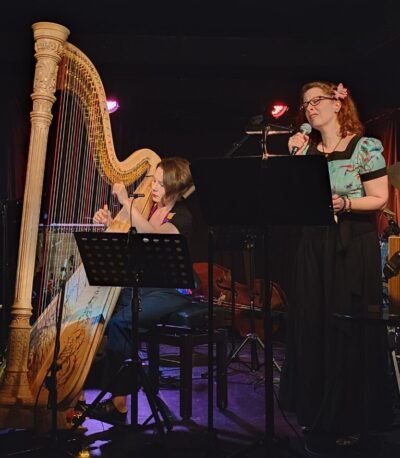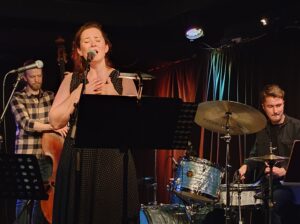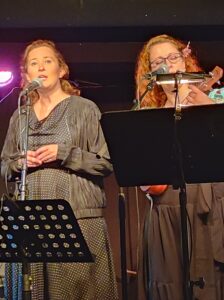By Ivonne Carlos
For one reason or another, I hadn’t had the chance to write before about the Night or the Arts, my favorite day in Vaasa so far. This 2023, I enjoyed it entirely just as I thought it would be. Music in the streets, happy faces everywhere, some cute tantrums from children with painted faces and balloons in their hands here and there. Delicious food especially from the food trucks parked in Tori, a small but beautiful carnival parade full of energy and Indian dance, a little salsa and even some samba. It’s a pleasure just to walk the length and breadth of the city center and find options everywhere to stop and have a good time. I wanted to organize myself, check the program and decide which events I wanted to go to, enjoy the free and quality events to the fullest, but it was impossible for me to go to each one of them because several were at the same time and in a different location, like in some old places and houses of culture in the city. I went to the Culture House Fanny for example, but the heat inside was impossible for me to bear, so I continued my way through the streets. I can’t complain anyway, because what I witnessed was beautiful and sufficient… Could we really get enough?
It seems to me that the Night of the Arts is a good concrete and visible example of the democratization of art, but what do I mean by it? The quote below explains it briefly and adequately:
“The ethos of democratization includes the belief that every person has the right to engage in the arts. A democratic view of the arts argues that all individuals should be able to explore their creativity and appreciate the artistic works of others. Thus, the democratization of art increases public access and involvement in artworks through a form of ‘regime change’ (e.g. the development of new platforms for interactive art outside of ‘sanctioned’ gallery or museum spaces). There are, however, a number of interpretations of what democratization means for the arts and a variety of factors that influence the process. Art historians and sociologists of art measure democratization in terms of access, participation, interactivity, reciprocity and decentralization” (Ryan, p. 19-20)
I’m not saying the event is perfect, many things still need to be implemented, like expanding accessibility and diversity, increasing the artistic offer, and motivating the underground scene more. However, it’s definitely a good effort on the part of cultural agencies, volunteers, and artists who make it possible. Are more events and initiatives needed in Vaasa? Definitely. And of course, we must also highlight projects as important and interesting as those carried out by Platform, Ritz, Malakta and so on, of which I will talk little by little in this space. Even so, Vaasa still lacks other types of areas and proposals, there it is still much to be done in that sense in this city. Although, it is not only about democratizing art in the sense explained above but also about going further, problematizing cultural rights and encouraging cultural democracy, not leaving aside the infinite complexities that this entails and the need for a contextualized analysis. Quite a laborious task.
Mariah Hortans, Marian Junolainen and Carla Fri performances at the Doo-Bop club.
My favorite event of the night, wow and just wow, so enjoyable. We arrived about an hour early because it had already happened to me that in other events right there, we arrived ten minutes before the start time and we no longer had a good place to sit and see the stage well. So this time I didn’t want to risk it. An hour before and we chose a table right in front of the stage, with no places in front of us that could block our view. Mariah Hortans began singing with her refined and educated voice, accompanied by the exquisite harp of Marian Junolainen. I have been to many art events in different countries and I have never heard someone play the harp. I was fascinated and very entertained to observe the maneuvers with which Junolainen handled the ropes. Her hands looked like bird feathers falling gracefully and softly. She herself is a small woman and looks so delicate that it seems that the harp is an extension of herself. Then, Mariah Hortans sang playing a small box that she had hanging (I don’t know the name of the instrument), and it gave another dimension to her performance. Fri and Hortans sang together while the latter played the ukulele too.

Marian Junolainen with her harp and Mariah Hortans

Mostly Jazz II with Carla Fri

Carla Fri and Mariah Hortans with her ukulele
As if that were not enough, Carla Fri’s presentation started with an introductory Lindy Hop dance, and the energy in the environment rose to a more energetic level. The band Mostly Jazz came to create a more exciting atmosphere to the already joyful moment. The vitality and effervescence of Fri’s voice and presence on stage gave another boost to the evening’s program. That woman does not take half measures and lets herself go completely when she is singing. The expression of her body and the way in which she carries herself so openly and professionally on stage draws us towards her, and suddenly we cannot take our eyes off her as we move our restless feet around again and again, which by that moment only want to dance no matter what. It is clearly visible that she already has her long career and experience by the way she handles herself on stage.
Thus, the night ended with a sense of satisfaction and contentment. We returned home walking with the coolness of the night under the half light of the waning crescent moon. Nice while it lasted. Definitely, looking forward to the next one. For now, inspired by the dance of the group that introduced Fri during their presentation at the club, I have already signed up for the intensive Lindy Hop course. Let’s see how many stumbles I make.
Darder, Antonia. Scanning of book “Culture and Power in the Classroom: A critical foundation for bicultural education” (1991), 2011. Internet Archive, New York : Bergin & Garvey https://archive.org/details/culturepowerin00dard/page/n5/mode/2up?q=cultural+democracy
Ryan, J. Sustainability and Digital Art: Democratization, Globalization, and Interdisciplinarity. Preprint at University of New England at Armidale, NSW Australia https://rune.une.edu.au/web/bitstream/1959.11/20828/3/open/SOURCE02.pdf (September 2023).








